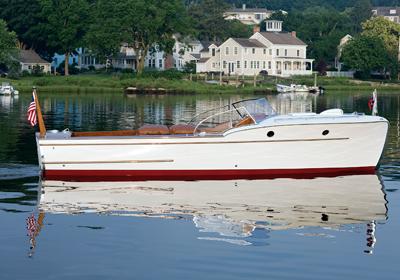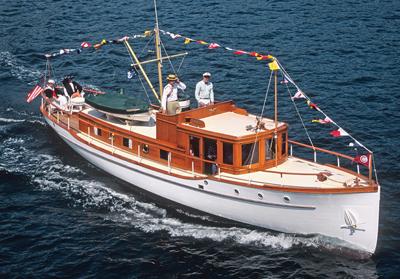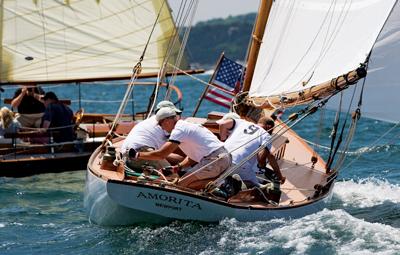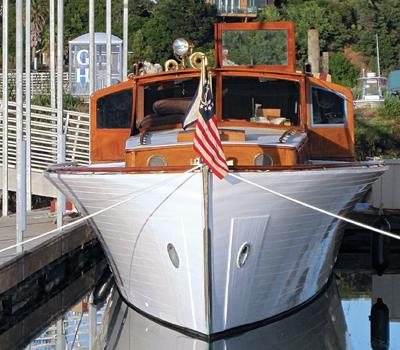This is a tale of passion; of nostalgia and dedication; of determination, commitment, investment; of wrenching heartbreak and grand pleasures.
It is a tale that many will find completely inexplicable. Why, after all, would anyone invest endless time, considerable effort, and untold dollars in the restoration and maintenance of a classic wooden yacht, when a perfectly good fiberglass yacht could be enjoyed for a fraction of those costs?
There is, of course, no easy answer. For some, it is about owning an irreplaceable piece of history. For others, it is about memories of another time and place, before fiberglass turned much of boating into cookie-cutter sameness. If you’ve ever stopped to watch a classic Corvette drive past, or looked up at the sound of an old Stearman biplane, or paused as an all-mahogany yacht slid into the harbor, then you already understand.
This is also a tale of four grande dames. Born into a kinder and gentler world, they expected—but didn’t always receive—the care they deserved. Some were cast aside for younger challengers and left to fend for themselves, and at least one has been rescued, more than once, from the edge of death.
But each has now flourished under nurturing care and, though all are more than half a century old, they exude a radiance and grace that is timeless.
This is the story of these four beauties and the people in their lives.

Eulipion
“I’m a heretic,” says Ken LeDonne, “and I think of a boat as sculpture.” Though he has a successful business as a contractor and developer in the Pittsburgh area, LeDonne is a sculptor both by training and passion, and he has passed that love along to his triplet 29-yearold sons. The LeDonnes all have “busy hands,” he admits, often carving wood together or learning about ceramics, but boating was not a part of Ken and wife Linda LeDonne’s life until son Ben suggested they build a boat together.
Days later, on September 10, 2001, Ken LeDonne was en route to a kayaking vacation in Maine when he spotted a derelict boat in the woods with a “For Sale” sign on it. He stopped to look at the boat and then continued his trip, but the events of the next day—now known as 9/11—made him want to bond his family with a project. “When the towers went down, I knew we had to be together.”
They bought the weathered and rotting 25-foot launch, which they called the “gray boat” for its color and condition. Over the next four years, they took it apart and rebuilt it, not as a restoration, but to become a gorgeous center console of varnished mahogany and teak.
That launch, named YNOT, whetted their appetite, and they soon found a 25-foot 1947 Chris-Craft Express Cruiser in Mattituck, New York, which was advertised as “sound.” They bought it, but looks were deceiving: The bottom was held together with plywood and roofing tar and every frame was broken. Back to Pittsburgh—the family had a new project.
Three years later, the Chris-Craft, which had been called a Red and White Express in its heyday after World War II, was finished. In the process, they had rebuilt every inch of the yacht: new bottom, new topsides, new deck, new interior, and new engine. They even bought two other Chris Craft Express Cruisers to get all the original parts they needed.
“We have no shortage of ego,” he says, but adds, “Working on this boat made us very humble. At every turn, there was a reminder that human hands had lovingly created this so long ago, and we are the curators of that aesthetic.”
The LeDonnes are now looking for other boat restoration projects, and Ken is clear about the joys. “No one needs a boat but, for us, it’s a connection with art. Being on the water in a vintage boat is like a piece of music.”
He is also equally clear about the pains and the investment. “Wooden boats exist because of people. Fiberglass boats don’t really need us. So if you love this thing, then you’ll take care of it…you’ll invest the time in it.”
“Boating is about the dream,” he notes. “You spend more time dreaming about it than actually doing it. So, the dream has to be really good, and that’s how it is with Eulipion.”
But unlike car restorers who are afraid to drive their creations, the LeDonnes get their pleasure on the water with Eulipion. “She’s beautiful, but she’d never win a concours. And we love every minute aboard!”

Kiyi
“We’ve never felt that we owned her,” says Tom Henderson about Kiyi, their 50-foot 1926 fantail motoryacht. “We’re just the caretakers,” adds his wife, Patty. They may be just the caretakers, but taking care of Kiyi has turned into a 33-year career.
Though a workday at their GTH Design business in Poulsbo, Washington, is spent creating stunning interiors for modern megayachts, their weekends are spent in the past aboard Kiyi. “I’m very familiar with every inch of her,” grins Patty, “because I’ve sanded and varnished every one of those inches!” Adds Tom, “A weekend for me is about being aboard and just ‘fussing with stuff.'”
Their yacht is a classic Pacific Northwest design by Leigh Coolidge, built by the Schertzer Brothers on Lake Union. If you don’t think they built them differently back then, consider that the house is planked in solid teak, 1 1/8-inches thick and as long as 18 feet. The hull is Port Orford cedar over bent oak frames, and she cost a pre-Depression $5,280, even though the owner supplied the wood planking.
Kiyi is on her ninth set of “caretakers” and has always been kept in a covered boathouse, but she still requires continual maintenance. Right now, she’s in a boatyard getting new canvas decking. The Hendersons have refit her every couple of years: refastening the garboards, new floor timbers, keel bolts. Each is a major project and, says Tom, “It’s not for the faint of heart…or pocketbook! It takes a real commitment, but we do it because we love her.”
Kiyi is on her third engine, a classic 6-cylinder Chrysler Crown of just 110 horsepower, while the previous engine was an 8-cylinder Chrysler Royal that replaced the original Hall Scott. “She’s not fast,” he says, “but she’s comfortable and economical.”
The Hendersons raised their three sons (now grown) aboard Kiyi and Patty says, “We live on the water. We have small boats that we sail or row, and Kiyi has always been part of our family.” When heading for a weekend in the Gulf Islands, they often tow a classic 100-year-old Whitehall rowing tender.
Though 50 feet long, she has an interior more like a sailboat, since she has just 10 feet of beam. “The fantail takes away some interior space,” says Patty, “but it’s a wonderful place to sit in a couple of wicker chairs on a sunny day.” That fantail is unique on a boat this size, and it fascinates people who see her. Kiyi draws attention wherever she goes. “People will stop us and say they remember seeing her when they were kids. It’s wonderful, because these boats have heart and soul and history.”
With a space-consuming dinette removed and a flybridge added in the ’60s, not all of Kiyi is completely original—but the unusual curved-glass pilothouse windows are. “When our kids were playing around on deck, I told them: You break the glass, you die!” says Patty with a grin.
The Hendersons can’t wait for Kiyi to get back in the water, where they can take care of her again. “As owners of a classic yacht, you’re really museum keepers,” they say fondly.

Amorita
“It was the worst moment of my life,” says Jed Pearsall. His precious Amorita, a 102-year-old New York 30 sloop, had just been rammed by a 94-foot ketch during a classic yacht race and was sinking fast. “I stayed with her until she sank under me and, as her deck went down, patted her, and said I’d be back.”
As he promised, Pearsall raised the gaff-rigged yacht from the bottom off Rhode Island three days later and took her to a shed. The ensuing three years have been painful, as the other owner and insurance companies fought over who would assume responsibility for repairing the irreplaceable classic that was now, says Pearsall, “about 30 percent splinters!” But, as YACHTING goes to press, Amorita is undergoing a full restoration…again.
Bill Doyle, Amorita’s co-owner, is upbeat, “Amorita has such spirit and determination. If she had less soul, she’d have been cut up and gone long ago. This is her fourth life so far.”
Amorita was the ninth of 18 sloops designed and built by the great Nathanael Herreshoff for members of the New York Yacht Club. Built during the winter of 1904-1905, the yachts were complete— right down to matching china, tufted green corduroy cushions, and pleated curtains.
Amorita was actively raced until 1939, when she was moved to the Great Lakes and dropped out of sight. By 1975, she had been through several owners and was in disrepair in a boatyard that was going to chainsaw her to salvage the lead keel. But the surveyor hired to value the project recognized her significance and found a buyer for her just 30 minutes before she was to be destroyed.
This was, at best, a temporary delay. She was minimally patched up, sold, and then donated to a charitable foundation. At this point, the Pearsall family entered the scene with Jed’s father, Adrian, buying the boat in 1981 and lavishing a total restoration that took her back to original specifications. The project included reframing, new decks and cabin, new interior, and new gaff rig. In 1983, Amorita was taken to Newport, Rhode Island, to debut in the spectator fleet during the America’s Cup races.
“Dad wanted to save the boat,” says Pearsall of his late father, “and he couldn’t just walk away. Neither can we now.” Adds Doyle, “There is something intangible about her, an emotional bond. She’ll be back.”
So Amorita has been in the Pearsall family for 39 years, sailed in many races by Pearsall and Doyle. But this wasn’t her only brush with death. In 1986, her mooring lines chafed through and she drifted several miles down tricky channels to gently stop just 15 feet from a rock wall. (Who says boats don’t have spirit?)
Pearsall and Doyle are not exactly boat-less during the restoration, however, since they own several other classics ranging from a P-Class sloop to a vintage 1920s Fife-designed Six-Meter. But Amorita is clearly their true love.
And she is loved by others, too. The families of previous owners, including one that used Amorita as their Christmas card image for a dozen years, stay in touch and come to visit her when they are in town. “She’s like an adopted child,” says Doyle. “We’ve committed to care for her but, eventually, she’ll move on to someone else. Amorita will outlive us all, and we’ll just be a couple of time-lines on her history.”
Do they have any advice for potential buyers of classic yachts? “The boat has to speak to you,” says Pearsall, “There has to be a connection.” But Doyle is more pragmatic: “It’s like falling in love. You just can’t give any practical advice to anyone else.”

Ida May
“She was so dilapidated, but the moment I saw her, I felt this amazing positive energy to her,” says Dr. Bob Salk of his 46-foot 1926 wooden sportfisherman, Ida May. Now on San Francisco Bay, Ida May isn’t just any battlewagon: she set the stage for future sportfishing boats when she was designed and built in Los Angeles Harbor by Hugh Angelman, better known for his world-ranging ketches.
Considered to be the most expensive ($120,000!) yacht of her time, she was built for avid angler Willard Van Brunt, cofounder of John Deere. With a tripleplanked mahogany hull and a beam of just over 11 feet, she was also the fastest yacht in the area. Named for Van Brunt’s wife, Ida May was regularly anchored off the famous Tuna Club on Catalina Island, and she fished the local waters with an array of celebrities. Ernest Hemingway and western writer Zane Grey landed swordfish from the Ida May, and President Herbert Hoover said he was “well-satisfied,” even though he didn’t land a fish.
But the Ida May was just beginning her celebrity career. Sold in 1935 to Stan Laurel of the Laurel and Hardy comedy team and renamed for Laurel’s wife as the Ruth-L, she was as much a part of the Hollywood scene as the Academy Awards. Regulars aboard included Charlie Chaplin, Joseph Kennedy, Cecil B. DeMille, W.C. Fields, Bing Crosby, Gloria Swanson, Babe Ruth, Liberace and, of course, Oliver Hardy.
Laurel sold her three years later to Jonah Jones, who was Howard Hughes’s attorney and founder of Long Beach Yacht Club. Again, the guest list was distinguished, ranging from crooner Rudy Vallee to the Prince of Kuwait to, of course, Hughes, who shot at seagulls with his pistol. Even World War II, when the now-named Nada III was used by the Coast Guard to patrol the Catalina Channel, brought celebrities aboard—she was crewed by the likes of Donald Douglas (Douglas Aircraft) and heavyweight champ Jack Dempsey, then a Coast Guard commander.
When Salk saw Ida May, she had been partially restored by Paul Arnold, an actor who Salk credits with saving the yacht. “I called my best friend for advice,” recalls Salk, “because my wife would never approve of buying the boat.” The advice was obviously “Buy it!” and, even though Salk was just out of residency and not really looking for such a project, “I just couldn’t let her go. Others have to appreciate this yacht…it’s a piece of American history.”
Since that time, Salk and his good-advice friend, Steve Wynn, have invested thousands of hours in restoring the yacht. “I don’t think there’s one inch that we haven’t sanded,” Salk groans. He negotiated with the John Deere company for engines, but just discovered they are too large for the space available. So the Ida May is an immovable weekend getaway until the engine issue is resolved.
Like other owners of classic yachts, Salk has been contacted by previous owners, including the family of Jonah Jones, who gave him the priceless gift of the original log books, as well as several original fishing rods. A collector discovered Laurel’s brass yacht clock at a yard sale and presented it to Salk, and the great grandson of Laurel’s captain contacted him to visit the yacht.
Ida May’s ornate interior is the original varnished teak, with beveled-glass windows and cut-glass lights. The built-in bookshelves hold an early edition of Hemingway’s Old Man and The Sea, and the cockpit still has the original teak and brass fighting chairs, bait well, and tackle boxes.
Just sitting on the leather settees makes you imagine twilight at anchor off Catalina, with Hemingway telling tales and slugging down daiquiris, or Charlie Chaplin laughing about a Hollywood episode while Stan Laurel leans over the side in the cockpit to rinse off the dinner dishes (a frequent occurrence). Today, the Ida May remains as a place and a moment frozen in time.
Four wonderful yachts and four sets of…whatever you wish to call them—owners, caretakers, or curators. It isn’t always easy being responsible for a classic yacht, but it is clearly worth the effort. Have you got enough heart and soul to care for a classic?









